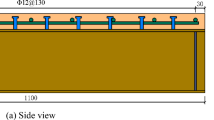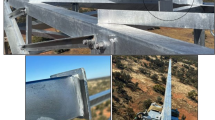Abstract
Q235B and Q345B are two structural steel grades widely used in China. In previous studies, more precisely in 2012, Nie defined a normalized constitutive model using material damage accumulation to describe damage behavior of Q235B steel in circular tubes. This paper focuses on the hysteretic damage behavior of Q345B steel in a circular steel tube under cyclic loads and describes the damage mechanism through a damage constitutive model based on experimental results. Three equations are implemented in the constitutive model, which includes a damage index to accurately describe the plastic and damage behavior of the material. Experiments were conducted in which a cyclic loading is applied in three directions on a circular steel tube. The constitutive model was implemented in the ABAQUS FEA software through a user-defined subroutine. Some parameters in the constitutive model were calibrated based on the experimental and numerical results. The performance behavior of a single-layer reticulated dome under seismic motion record was investigated through the increment dynamic analysis method. The results indicate that the constitutive model is suitable for analyses and quantifying seismic damage accumulation and progressive failure and it is also beneficial for investigating the nonlinear dynamic behavior of structures under seismic loads. The effect of accumulated material damage can describe large-scale structural deformation and obvious reduction in the failure limit load.







Similar content being viewed by others
References
ABAQUS theory manual Version 6.14. (2014a). Pawtucket, R.I.: Hibbitt, Karlsson & Sorensen, Inc.
ABAQUS user’s manual Version 6.14. (2014b). Pawtucket, R.I: Hibbitt, Karlsson & Sorensen, Inc.
Ayhen, B., Jehel, P., Brancherie, D., & Lbrahimbegovic, A. (2013). Coupled damage-plasticity model for cyclic loading: Theroretical formulation and numerical implementation. Engineering Structures, 50, 30–42.
Calvin, M. S., Ali, P. G., Young, W. M., & Richard, W. N. (2011). An anisotropic tertiary creep damage constitutive model for anisotropic materials. International Journal of Pressure Vessels and Piping, 88, 356–364.
Correia, J. A. F. O., de Jesus, A. M. P., Fernández-Canteli, A., & Calçada, R. A. B. (2015). Modelling probabilistic fatigue crack propagation rates for a mild structural steel. Frattura ed Integrita Strutturale, 31, 80–96.
De Jesus, A. M. P., & Correia, J. A. F. O. (2013). Critical assessment of a local strain-based fatigue crack growth model using experimental data available for the P355NL1 steel. Journal of Pressure Vessel Technology, Transactions of the ASME, 135(1), 11404.
De Jesus, A. M. P., da Silva, A. L. L., Figueiredo, M. V., Correia, J. A. F. O., Ribeiro, A. S., & Fernandes, A. A. (2011). Strain-life and crack propagation fatigue data from several portuguese old metallic riveted bridges. Engineering Failure Analysis, 18(1), 148–163.
Fan, F., Nie, G. B., & Zhi, X. D. (2011). Constitutive model of circular steel tubes under complicated cyclic load. Journal of Building Structures, 32(8), 59–68.
Hearn, G., & Testa, R. B. (1991). Modal analysis for damage detection in structures. Journal of Structural Engineering, 117(10), 3042–3063.
Kang, G. Z., Liu, Y. J., Ding, J., & Gao, Q. (2009). Uniaxial ratcheting and fatigue failure of tempered 42CrMo steel: Damage evolution and damage-coupled visco-plastic constitutive model. International Journal of Plasticity, 25, 838–860.
Khoo, H. A., Hrudey, T. M., & Cheng, J. J. R. (2006). Microvoid damage model with material dilation for ductile fracture. Journal of Engineering Mechanics, 132(10), 1067–1076.
Kunc, R., & Prebil, I. (2003). Low-cycle fatigue properties of steel 42CrMo4. Materials Science and Engineering A, 345, 278–285.
Li, Z. X., Jiang, F. F., & Tang, Y. Q. (2012). Multi-scale analyses on seismic damage and progressive failure of steel structures. Finite Elements in Analysis and Design, 48, 1358–1369.
Mashayekhi, M., Ziaei-Rad, S., Parvizian, J., Niklewicz, J., & Hadavinia, H. (2007). Ductile crack growth based on damage criterion: Experimental and numerical studies. Mechanics of Materials, 39, 623–636.
Naumenko, K., & Kostenko, Y. (2009). Structural analysis of a power plant component using a stress-range-dependent creep-damage constitutive model. Materials Science and Engineering A, 510–511, 169–174.
Necati, C. F., & Emin, A. A. (2002). Condition and damage assessment: Issues and some promising indices. Journal of Structural Engineering, 128(8), 1026–1035.
Nie, G. B., Dai, J. W., Zhang, C. X., & Zhi, X. D. (2015). Failure patterns of large span space structures in Lushan earthquake and numerical simulation. China Civil Engineering Journal, 48(4), 1–6.
Nie, G. B., Fan, F., & Zhi, X. D. (2012). A constitutive model for circular steel pipe by spatial hysteretic test. Advances in Structural Engineering, 15(8), 1278–1290.
Nie, G. B., Zhi, X. D., Fan, F., & Dai, J. W. (2014). Seismic performance evaluation of single-layer reticulated dome and its fragility analysis. Journal of Constructional Steel Research, 100, 176–182.
Noban, M., Jahed, H., & Varvani-Farahani, A. (2012). The choice of cyclic plasticity models in fatigue life assessment of 304 and 1045 steel alloys based on the critical plane-energy fatigue damage approach. International Journal of Fatigue, 43, 217–225.
Park, Y. J., & Ang, A. H. S. (1985). A Mechanistic seismic damage model for reinforced concrete. Journal of Structural Engineering, 111(4), 722–739.
Park, W. S., Lee, C. S., Chun, M. S., Kim, M. H., & Lee, J. M. (2011). Comparative study on mechanical behavior of low temperature application materials for ships and offshore structures: Part II-Constitutive model. Materials Science and Engineering A, 528, 7560–7569.
Pereira, J. C. R., de Jesus, A. M. P., Fernandes, A. A., & Varelis, G. (2015). Monotonic, low-cycle fatigue, and ultralow-cycle fatigue behaviors of the X52, X60, and X65 piping steel grades. Journal of Pressure Vessel Technology, 138(3), 31403–31410.
Pereira, J. C. R., Wittenberghe, J. V., de Jesus, A. M. P., Philippe, Thibaux, Correia, J. A. F. O., & Fernandes, A. A. (2018). Damage behaviour of full-scale straight pipes under extreme cyclic bending conditions. Journal of Constructional Steel Research, 143, 97–109.
Powell, G. H., & Allchabadi, R. (1988). Seismic damage prediction by deterministic methods: Concept and procedures. Earthquake Engineering and Structural Dynamics, 16(5), 719–734.
Sanchez-Santana, U., Rubio-Gonzalez, C., Mesmacque, G., Amrouche, A., & Decoopman, X. (2008). Dynamic tensile behavior of materials with previous fatigue damage. Materials Science and Engineering A, 497, 51–60.
Tanguy, B., Luu, T. T., Perrin, G., Pineau, A., & Besson, J. (2008). Plastic and damage behaviour of a high strength X100 pipeline steel: Experiments and modelling. International Journal of Pressure Vessels and Piping, 85, 322–335.
Yu, C., & Steve, L. (2003). Analysis of ductile tearing of pipeline-steel in single edge notch tension specimens. International Journal of Fracture, 124, 179–199.
Zhi, X. D., Nie, G. B., Fan, F., & Shen, S. Z. (2012). Vulnerability and risk assessment of single-layer reticulated domes subjected to earthquakes. Journal of Structural Engineering, 138, 1505–1514.
Zhou, F., Chen, Y. Y., & Wu, Q. (2015). Dependence of the cyclic response of structural steel on loading history under large inelastic strains. Journal of Constructional Steel Research, 104, 64–73.
Acknowledgements
This study is jointly sponsored by China Earthquake Administration Fundamental Research Program (2018B12), National Natural Science Foundation of Heilongjiang Province, China (E2016071) and Program for Innovative Research Team in China Earthquake Administration.
Author information
Authors and Affiliations
Corresponding author
Rights and permissions
About this article
Cite this article
Nie, G., Zhang, C., Zhi, X. et al. A Damage Constitutive Model of Q345B Steel in Circular Tubes Based on Cyclic Experiments and Its Application on Structure. Int J Steel Struct 19, 469–477 (2019). https://doi.org/10.1007/s13296-018-0137-4
Received:
Accepted:
Published:
Issue Date:
DOI: https://doi.org/10.1007/s13296-018-0137-4




